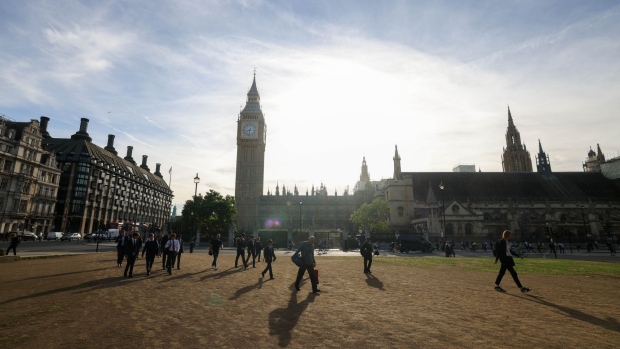Sep 23, 2022
UK Bonds Plunge as Government Ramps up Borrowing More Than Expected
, Bloomberg News

(Bloomberg) -- Investors dumped UK assets, sending bonds on a historic plunge and the pound to a 37-year low, as the new government’s stimulus will balloon the country’s debt and stoke inflation.
The yield on 10-year bonds jumped 35 basis points, set for the biggest increase on record, after Chancellor of the Exchequer Kwasi Kwarteng outlined tax cuts and spending plans. The pound plunged as much as 3.2% against the dollar to below $1.09 for the first time since 1985.
To fund the stimulus, the nation’s Debt Management Office lifted its government bond sales for this fiscal year by £62.4 billion ($69.8 billion), even more than an estimated £60 billion increase expected by banks surveyed by Bloomberg.
“Gilt yields up and the pound down is a very worrying combination, as it is indicative of markets pricing in risk premia to the UK,” said Mike Riddell, a portfolio manager at Allianz Global Investors. “It’s a clear sign that the UK’s inflation fighting credibility is at stake.”
The borrowing led traders to ramp up wagers on more aggressive BOE rate hikes to tackle inflationary pressures. Money markets are fully pricing a one percentage-point move from the central bank at its next policy decision in November -- the last time it delivered an increase of that size was 1989.
While markets expected more debt and some tax changes, Liz Truss’s government set out the most radical package of tax cuts for the UK since 1972, reducing levies both on worker pay and companies. The total cost of the package is expected to run to £161 billion over the next five years.
The additional borrowing required to finance this spending threatens to widen the UK’s budget and current-account deficits. Strategists fear that this forms another pressure on the currency and bonds, as the UK becomes more reliant on external capital flows to finance the shortfall.
The nation’s current-account deficit widened to 8.3% of GDP in the first quarter, the most in data going back to 1997.
“The issue facing sterling is now the projected balance of payments, which in the short term will suffer from some of the measures in the mini-budget,” said Fredrik Repton, a portfolio manager at Neuberger Berman, adding that the current-account deficit could widen to 10% of GDP. “The UK may have to attract capital through higher rates, lower FX and investment opportunities and incentives.”
Pound at Parity Is No Longer a Far-Fetched Idea for Options Bets
The extra bond supply from the UK government might prove especially challenging for the gilt market now that the BOE is also offloading debt from its portfolio, in stark contrast to during the pandemic when they were buying gilts under quantitative easing. The central bank said Thursday it plans to sell around £10 billion in gilts each quarter starting on Oct. 3.
“Clearly the prospect of more debt-financed tax cuts is spooking gilt investors,” said Antoine Bouvet, a senior rates strategist at ING Groep NV. “It’s a perfect storm for gilts.”
The additional debt plans by the DMO, taking total sales to £193.9 billion, will also see an increase in the proportion of short- and medium-maturity bonds versus initial plans in April. The DMO concentrated on these sectors since they are the most deep and liquid, and hence suited to raising additional financing in a short amount of time, said Robert Stheeman, chief executive officer of the DMO.
Totted up, the market may have to digest around three times the pre-pandemic average over the coming years after accounting for previous BOE bond buying, according to a NatWest Markets estimate earlier this week.
“If necessary, market pricing will have to adjust in order to absorb that supply,” said Stheeman in an interview. “We are a price taker, not a price maker.”
(Updates with context and moves throughout.)
©2022 Bloomberg L.P.





